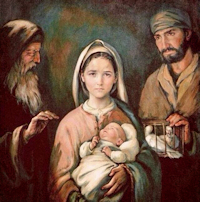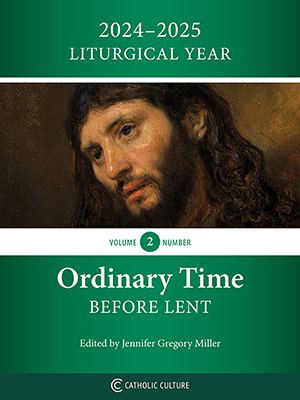Ordinary Time: February 2nd
Feast of the Presentation of the Lord
Other Commemorations: St. Catherine de Ricci, Virgin (RM) ; Other Titles: Candlemas
» Enjoy our Liturgical Seasons series of e-books!
Today the Church celebrates the feast of the Presentation of the Lord which occurs forty days after the birth of Jesus and is also known as Candlemas day, since the blessing and procession of candles is included in today's liturgy.
Founded by Pope St. John Paul II in 1997, today is the World Day of Prayer for Consecrated Life. He attached it to "Candlemas Day" because the consecrated men and women are to be the light in the world, imitating Jesus, the Light of the World. The World Day of Prayer is moved to the following Sunday to be celebrated in the parishes. See USCCB for more resources.
The previous (1962) liturgical calendar refers to this feast as the "Purification of Mary." This is known as a "Christmas feast" since it points back to the Solemnity of Christmas. Many Catholics practice the tradition of keeping out the Nativity creche or other Christmas decorations until this feast.
On February 2nd another secular tradition unfolds, known well to schoolchildren and adults alike. The fate of Spring hangs in the balance as a burrowing animal looks for its shadow. But where did this tradition come from? See the link below for an article that explains this tradition.
The Readings
Today's first reading gives us an important insight to understand profoundly the mystery of the Lord’s Presentation in the Temple by Mary and Joseph, in accordance with the canons of Mosaic Law. The text, taken from the Prophet Malachi says, ‘I am sending my messenger to prepare the way before me; and suddenly there will come to the temple the Lord who you seek’ (Mal 3:1). From all the Gospels, we know that it is the Precursor, St John the Baptist who was born 6 months before Jesus, that God sent to prepare His way. Putting these evangelical facts together, we can comprehend the words of the Prophet Malachi. The Lord God promised that He would send a Precursor to prepare His way. Since there is only 6 months between the birth of St John the Baptist and Jesus it is clear that the prophecy meant that suddenly after the Precursor, the Lord Himself will come. So, soon after the Baptist’s birth, God entered His temple. Jesus’ presentation signifies God’s entrance to His temple. God made man entered His temple, presenting Himself to those who were really searching for Him.
Today’s Gospel introduces us to different people and events that in themselves provide numerous lessons and themes for further reflection. First of all, Mary and Joseph respect the Mosaic Law by offering the sacrifice prescribed for the poor: a pair of turtledoves or two young pigeons.
Simeon and Anna were two venerable elderly people dedicated to prayer and fasting and so their strong religious spirit rendered them able to recognize the Messiah. In this sense we can see in the Presentation of Jesus in the Temple an extension of the ‘Pro Orantibus Day’ (For those who pray) that is celebrated on the feast of the Presentation of Mary (21 November). On this day, the Church demonstrates its gratitude to all those in the community that dedicate themselves in a privileged way to prayer, to those who have a particular religious vocation to the contemplative life. In the figure of the venerable Simeon, Jesus’ presentation in the temple, also reminds us that prayer and contemplation are not just a waste of time or an obstacle to charity. On the contrary, time could not be better spent than in prayer as true Christian charity is a consequence of a solid interior life. Only those who pray and offer penance, like Simeon and Anna, are open to the breath of the Spirit. They know how to recognize the Lord in the circumstances in which He manifests Himself because they possess an ample interior vision, and they have learned how to love with the heart of the One whose very name is Charity.
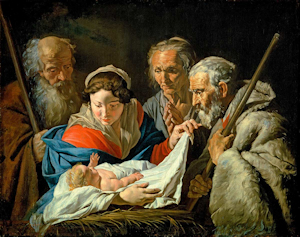 At the end of the Gospel Simeon’s prophecy of Mary’s sufferings is emphasized. Pope John Paul II taught that, ‘Simeon's words seem like a second Annunciation to Mary, for they tell her of the actual historical situation in which the Son is to accomplish his mission, namely, in misunderstanding and sorrow.’ (Redemptoris Mater, n16) The archangel’s announcement was a fount of incredible joy because it pertained to Jesus’ messianic royalty and the supernatural character of His virginal conception. The announcement of the elderly in the temple instead spoke of the Lord’s work of redemption that He would complete associating Himself through suffering to His Mother. Therefore, there is a strong Marian dimension to this feast and so in the Liturgical Calendar of the Extraordinary Form it is called the Purification of the Blessed Virgin Mary. This refers to the other aspect of the presentation that consists of the ritual purification of Jewish women after they had given birth. In Mary’s case this purification was not necessary, but it indicates the renewal of her total offering of herself to God for the accomplishment of His Divine Plan.
At the end of the Gospel Simeon’s prophecy of Mary’s sufferings is emphasized. Pope John Paul II taught that, ‘Simeon's words seem like a second Annunciation to Mary, for they tell her of the actual historical situation in which the Son is to accomplish his mission, namely, in misunderstanding and sorrow.’ (Redemptoris Mater, n16) The archangel’s announcement was a fount of incredible joy because it pertained to Jesus’ messianic royalty and the supernatural character of His virginal conception. The announcement of the elderly in the temple instead spoke of the Lord’s work of redemption that He would complete associating Himself through suffering to His Mother. Therefore, there is a strong Marian dimension to this feast and so in the Liturgical Calendar of the Extraordinary Form it is called the Purification of the Blessed Virgin Mary. This refers to the other aspect of the presentation that consists of the ritual purification of Jewish women after they had given birth. In Mary’s case this purification was not necessary, but it indicates the renewal of her total offering of herself to God for the accomplishment of His Divine Plan.
Simeon’s prophecy also announces that Christ will be ‘a sign of contradiction’. St Cyril of Alexandria, in one of his homilies, interpreted the words ‘sign of contradiction’ like a noble cross, as St Paul wrote to the Corinthians ‘a stumbling block to Jews and foolishness to Gentiles’ (1 Cor 1:23) […] It is a sign of contradiction in the sense that those who loose appear as foolish while in those who recognize its power [the cross] reveals salvation and life’ (c.f PG 77, 1044-1049).
—Excerpted from Congregation for the Clergy
Presentation of the Lord
The feast was first observed in the Eastern Church as "The Encounter." In the sixth century, it began to be observed in the West: in Rome with a more penitential character and in Gaul (France) with solemn blessings and processions of candles, popularly known as "Candlemas." The Presentation of the Lord concludes the celebration of the Nativity and with the offerings of the Virgin Mother and the prophecy of Simeon, the events now point toward Easter.
"In obedience to the Old Law, the Lord Jesus, the first-born, was presented in the Temple by his Blessed Mother and his foster father. This is another 'epiphany' celebration insofar as the Christ Child is revealed as the Messiah through the canticle and words of Simeon and the testimony of Anna the prophetess. Christ is the light of the nations, hence the blessing and procession of candles on this day. In the Middle Ages this feast of the Purification of the Blessed Virgin Mary, or 'Candlemas,' was of great importance.
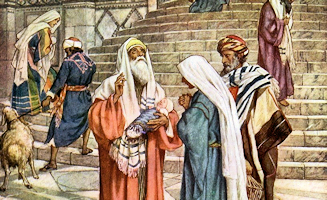 "The specific liturgy of this Candlemas feast, the blessing of candles, is not as widely celebrated as it should be, except of course whenever February 2 falls on a Sunday and thus takes precedence. There are two ways of celebrating the ceremony, either the Procession, which begins at a 'gathering place' outside the church, or the Solemn Entrance, celebrated within the church."
"The specific liturgy of this Candlemas feast, the blessing of candles, is not as widely celebrated as it should be, except of course whenever February 2 falls on a Sunday and thus takes precedence. There are two ways of celebrating the ceremony, either the Procession, which begins at a 'gathering place' outside the church, or the Solemn Entrance, celebrated within the church."
—From Ceremonies of the Liturgical Year
Until 1969, the ancient feast of the Presentation of Our Lord, which is of Oriental origin, was known in the West as the Feast of the Purification of Our Lady, and closed the Christmas Cycle, forty days after the Lord's birth. This feast has for long been associated with many popular devotional exercises. The faithful:
- gladly participate in the processions commemorating the Lord's entry into the Temple in Jerusalem and His encounter with God, whose house He had come to for the first time, and then with Simeon and Anna. Such processions, which in the West had taken the place of licentious pagan events, always had a penitential character, and were later identified with the blessing of candles which were carried in procession in honor of Christ, 'the light to enlighten the Gentiles' (Lk 2, 32);
- are sensitive to the actions of the Blessed Virgin in presenting her Son in the Temple, and to her submission to the Law of Moses (Lk 12, 1-8) in the rite of purification; popular piety sees in the rite of purification the humility of Our Lady and hence, 2 February has long been regarded as a feast for those in humble service.
Popular piety is sensitive to the providential and mysterious event that is the conception and birth of new life. Christian mothers can easily identify with the maternity of Our Lady, the most pure Mother of the Head of the mystical Body—notwithstanding the notable differences in the Virgin's unique conception and birth.
These too are mothers in God's plan and are about to give birth to future members of the Church. From this intuition and a certain mimesis of the purification of Our Lady, the rite of purification after birth was developed, some of whose elements reflect negatively on birth.
The revised Rituale Romanum provides for the blessing of women both before and after birth, this latter only in cases where the mother could not participate at the baptism of her child.
It is a highly desirable thing for mothers and married couples to ask for these blessings which should be given in accord with the Church's prayer: in a communion of faith and charity in prayer so that pregnancy can be brought to term without difficulty (blessing before birth), and to give thanks to God for the gift of a child (blessing after birth).
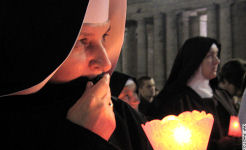 In some local Churches, certain elements taken from the Gospel account of the Presentation of the Lord (Lk 2, 22-40), such as the obedience of Joseph and Mary to the Law of the Lord, the poverty of the holy spouses, the virginity of Our Lady, mark out 2 February as a special feast for those at the service of the brethren in the various forms of consecrated life.
In some local Churches, certain elements taken from the Gospel account of the Presentation of the Lord (Lk 2, 22-40), such as the obedience of Joseph and Mary to the Law of the Lord, the poverty of the holy spouses, the virginity of Our Lady, mark out 2 February as a special feast for those at the service of the brethren in the various forms of consecrated life.
The feast of 2 February still retains a popular character. It is necessary, however, that such should reflect the true Christian significance of the feast. It would not be proper for popular piety in its celebration of this feast to overlook its Christological significance and concentrate exclusively on its Marian aspects. The fact that this feast should be 'considered [...] a joint memorial of Son and Mother' would not support such an inversion. The candles kept by the faithful in their homes should be seen as a sign of Christ 'the light of the world' and an expression of faith.
—Excerpted from Directory on Popular Piety and the Liturgy
Theme of Light
The Feast of the Presentation of the Lord's second major theme is Light. We are well familiar with the beautiful symbolism associated with light. Light means Christ and the supernatural life of grace. Today the Church, responding to Simeon's words, "The Light for the enlightenment of the Gentiles," keeps a genuine "light feast." (The feast was instituted to supplant the pagan Lupercalia, a licentious frolic featuring nocturnal torchlight parades. This explains why at the blessing of the candles and in the procession the celebrant and his ministers used to wear violet, the penitential color.)
Candles are blessed for liturgical use and are also distributed to the faithful. In homes they should be lighted on the occasion of family devotions, in times of storm, household crises, or other dangers; also at the Communion of the sick and at the administration of the Sacrament of the Anointing of the Sick. The Church, moreover, wishes these candles to remind us of our baptismal candles; for the candles we held at baptism signified our heavenly adoption and our duties in the lay priesthood of Christ. Year after year we again receive a baptismal candle so that "with burning lamp" we may hasten to meet the Bridegroom when He comes for the heavenly nuptials.
In the older missal, on two occasions during today's Mass the faithful would light their candles and hold them, at the Gospel and during the Canon until Communion. For in the Gospel and during the Canon Christ is present in a special way. It is the reason why at a High Mass lighted candles and burning incense are introduced. The message which the Church wishes to tell you is this: Actually, you ought to hold burning candles in your hands at every Mass; ordinarily, however, acolytes perform that function in your stead. This feast, however, the lay people had an opportunity to exercise the office of universal or lay priesthood.—Today's Mass, therefore, is truly a "Candle-Mass," practically the only in the entire year.
—Excerpted from The Church's Year of Grace, by Pius Parsch
Highlights and Things to Do:
- Ask your parish priest to bless the candles that you will be using on your home altar/prayer table this year. Candles for liturgical uses formerly were required to be primarily of beeswax, but post Vatican II the candles need to be made of wax but the exact composition is determined by the local Ordinary. For cleaner burning, longer lasting, and less pollutants, beeswax is still the best option.
- Have a family Candlemas procession, found in the prayer links.
- Read Luke 2:22-35, the account of the presentation including the Canticle of Simeon.
- Meditate on the constant fiat of Our Lady of Sorrows, who embraced the will of God even as Simeon predicted that a sword would pierce her heart.
- Read more about the Feast of the Presentation of the Lord:
- Read this article to see what the connection between Candlemas and Groundhog Day.
- See Catholic Cuisine for a variety of clever food ideas for this feast day.
St. Catherine de Ricci
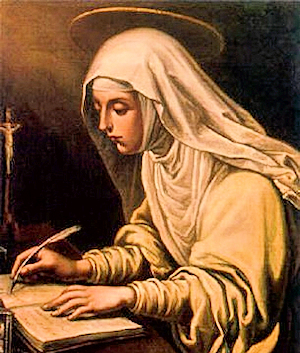 Catherine, who was born in 1522 in Florence, Italy as Alexandrina, changed her name on entering religious life at the age of thirteen, when she joined the nuns of the Dominican convent at Prato, in Tuscany, Italy. Through profound meditation on the Passion of Christ, she was able to withstand incredibly agonizing pain, and rose in her order to the position of novice mistress, sub-prioress and, at the age of thirty, to Prioress in perpetuity.
Catherine, who was born in 1522 in Florence, Italy as Alexandrina, changed her name on entering religious life at the age of thirteen, when she joined the nuns of the Dominican convent at Prato, in Tuscany, Italy. Through profound meditation on the Passion of Christ, she was able to withstand incredibly agonizing pain, and rose in her order to the position of novice mistress, sub-prioress and, at the age of thirty, to Prioress in perpetuity.
Her growing reputation for holiness and wisdom led many to seek her advice, not only from among the clergy and hierarchy but also from the secular rulers of the time. Three future popes— Marcellus II, Clement VII, and Leo XI— were among the thousands who sought her prayers. There is a story, confirmed by the oaths of five witnesses, that she appeared in more than one place at the same time. It is related that St. Catherine conversed with St. Philip Neri in Rome without having left her convent at Prato.
But even this is not the most famous aspect of Catherine's fabulous life. She is reputed to have had visions and ecstasies in which she not only beheld but actually enacted events in our Lord's life just before the Crucifixion. Except for a brief moment in which she took communion devoutly, Catherine seemed to be suspended in unconscious ecstasy for a period of twenty-eight hours, from noon of each Thursday to four o'clock on the following afternoon. During this time, her body followed out the movements of our Lord during his moments of agony, and she even spoke to those about her in related exhortations.
Catherine had the stigmata, and during the process of her canonization, detailed attention was given to the report that she wore at times a ring given her by Christ—apparently depositions were submitted that at times Catherine's finger showed the marks of a mysterious ring made of gold set with a diamond.
Despite the mystical bent of her life, Catherine was an energetic and efficient administrator, a person of sound mental and physical health, and happy in all her activities.
After a long illness St. Catherine died on February 2, 1589, at the age of sixty-seven. She was canonized by Pope Benedict XIV in 1747.
—Excerpted from The Encyclopedia of Catholic Saints, February and Heavenly Friends: A Saint for Each Day, by Rosalie Marie Levy
Patronage: against illness; sick people; pipe makers; tobacconists; Prato, Italy
Symbols and Representation: ring; crown; crucifix
Highlights and Things to Do:
- Read more about St. Catherine:
- Read the full text of her letters.
- St. Catherine's body is incorrupt and located in the Minor Basilica of Santi Vicenzo e Caterina de' Ricci, located in the town of Prato, in Tuscany, Italy. See image.


